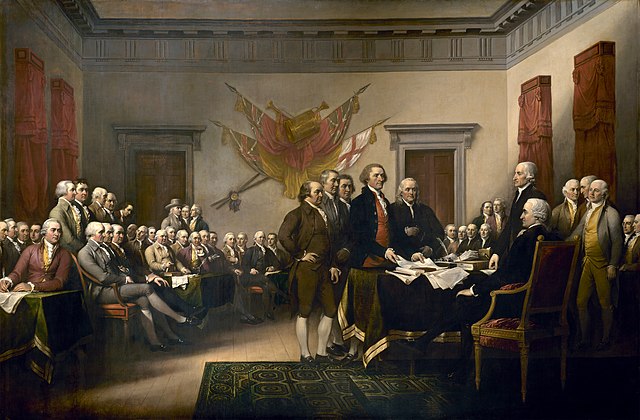Charles Carroll of Carrollton
Charles Carroll, known as Charles Carroll of Carrollton or Charles Carroll III, was an American politician, planter, and signatory of the Declaration of Independence. He was the only Catholic signatory of the Declaration and the longest surviving, dying 56 years after its signing.
Charles Carroll painted by Michael Laty
The Carroll family's coat of arms
Doughoregan Manor, the Carroll family seat, now a National Historic Landmark
Charles Carroll of Carrollton Portrait by Sir Joshua Reynolds, c. 1763 Yale Center for British Art
Signing of the United States Declaration of Independence
The signing of the United States Declaration of Independence occurred primarily on August 2, 1776, at the Pennsylvania State House in Philadelphia, later to become known as Independence Hall. The 56 delegates to the Second Continental Congress represented the 13 colonies, 12 of which voted to approve the Declaration of Independence on July 4, 1776. The New York delegation abstained because they had not yet received instructions from Albany to vote for independence. The Declaration proclaimed the signatory colonies were now "free and independent States", no longer colonies of the Kingdom of Great Britain and, thus, no longer a part of the British Empire. The signers’ names are grouped by state, with the exception of John Hancock, as President of the Continental Congress; the states are arranged geographically from south to north, with Button Gwinnett from Georgia first, and Matthew Thornton from New Hampshire last.

John Trumbull's 1819 painting, Declaration of Independence, depicts the five-man drafting committee of the Declaration of Independence presenting their work to the Second Continental Congress
The 56 signatures on the Declaration of Independence
The Syng inkstand was used during the 1776 signing of the Declaration and the 1787 signing of the U.S. Constitution
The U.S. Post Office in 1869 issued for the first time a stamp commemorating the signing of the Declaration of Independence.








